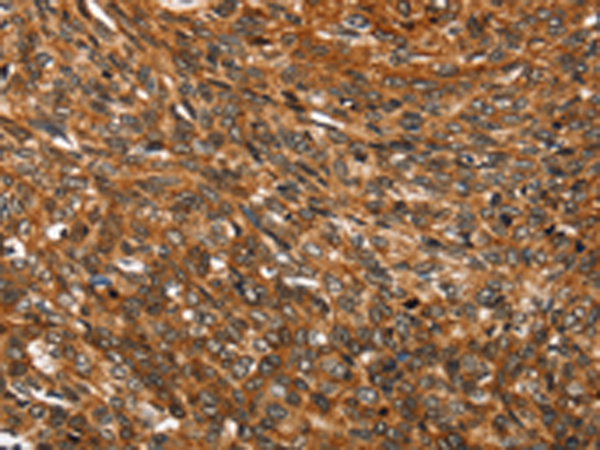


| WB | 1/200-1/1000 | Human,Mouse,Rat |
| IF | 咨询技术 | Human,Mouse,Rat |
| IHC | 1/30-1/150 | Human,Mouse,Rat |
| ICC | 技术咨询 | Human,Mouse,Rat |
| FCM | 咨询技术 | Human,Mouse,Rat |
| Elisa | 1/1000-1/2000 | Human,Mouse,Rat |
| Aliases | RDT; INI1; SNF5; Snr1; BAF47; MRD15; RTPS1; Sfh1p; hSNFS; SNF5L1; SWNTS1; PPP1R144 |
| WB Predicted band size | 44 kDa |
| Host/Isotype | Rabbit IgG |
| Antibody Type | Primary antibody |
| Storage | Store at 4°C short term. Aliquot and store at -20°C long term. Avoid freeze/thaw cycles. |
| Species Reactivity | Human, Mouse |
| Immunogen | Fusion protein of human SMARCB1 |
| Formulation | Purified antibody in PBS with 0.05% sodium azide and 50% glycerol. |
+ +
以下是3-4篇与SMARCB1抗体相关的参考文献摘要(文献标题、作者及核心内容概括):
---
1. **标题**:*Loss of SMARCB1/INI1 expression in poorly differentiated chordomas*
**作者**:Hasselblatt M et al.
**摘要**:研究通过免疫组化(使用SMARCB1抗体)分析低分化脊索瘤中SMARCB1蛋白的表达缺失,发现其缺失与肿瘤恶性程度相关,为诊断和预后提供了依据。
---
2. **标题**:*SMARCB1-deficient tumors of the head and neck: A clinicopathologic study of 10 cases*
**作者**:Agaimy A et al.
**摘要**:通过SMARCB1抗体检测头颈部肿瘤,发现SMARCB1缺失与上皮样肉瘤和横纹肌样瘤相关,强调了抗体在鉴别诊断中的关键作用。
---
3. **标题**:*Immunohistochemical analysis of SMARCB1/INI-1 expression in epithelioid sarcoma*
**作者**:Kohashi K et al.
**摘要**:研究使用SMARCB1抗体对上皮样肉瘤进行免疫组化分析,证实近90%病例存在SMARCB1表达缺失,支持其作为该肿瘤的生物标志物。
---
4. **标题**:*Utility of SMARCB1/INI1 antibody in diagnosing synovial sarcoma and malignant rhabdoid tumors*
**作者**:Sullivan LM et al.
**摘要**:验证SMARCB1抗体在滑膜肉瘤和恶性横纹肌样瘤中的诊断价值,发现SMARCB1缺失可作为区分其他软组织肿瘤的重要指标。
---
**备注**:以上文献标题和作者为简化示例,实际引用时需核对原文信息(可通过PubMed或学术数据库搜索关键词“SMARCB1 antibody”或“INI1 immunohistochemistry”获取具体文献)。
SMARCB1 (SWI/SNF-related matrix-associated actin-dependent regulator of chromatin subfamily B member 1), also known as INI1 or BAF47. is a core subunit of the SWI/SNF chromatin-remodeling complex. This complex regulates gene expression by altering chromatin structure, enabling access to transcription factors. The SMARCB1 gene is located on chromosome 22q11.2. and its encoded protein plays a critical role in controlling cell differentiation, proliferation, and apoptosis. Antibodies targeting SMARCB1 are widely used in research and diagnostics to detect the presence, localization, and expression levels of the protein in tissues or cells.
Loss of SMARCB1 protein expression, detectable via immunohistochemistry (IHC), is a hallmark of malignant rhabdoid tumors (MRTs) and epithelioid sarcomas, often caused by biallelic inactivation of the SMARCB1 gene. These antibodies also aid in diagnosing schwannomatosis-associated tumors and differentiating SMARCB1-deficient cancers from histologically similar malignancies. In research, SMARCB1 antibodies help elucidate the tumor-suppressive functions of the protein and its interplay with signaling pathways like Hedgehog and Wnt. Dysregulation of SMARCB1 is linked to aberrant SWI/SNF activity, contributing to oncogenesis. Recent studies explore its potential as a therapeutic target or biomarker in precision oncology. As a reagent, SMARCB1 antibodies require validation for specificity, given homologous proteins in the SWI/SNF family, ensuring accurate interpretation in both experimental and clinical contexts.
×